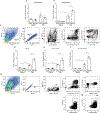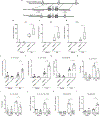Basophils prime group 2 innate lymphoid cells for neuropeptide-mediated inhibition
- PMID: 32807943
- PMCID: PMC9357342
- DOI: 10.1038/s41590-020-0753-y
Basophils prime group 2 innate lymphoid cells for neuropeptide-mediated inhibition
Abstract
Type 2 cytokine responses promote parasitic immunity and initiate tissue repair; however, they can also result in immunopathologies when not properly restricted. Although basophilia is recognized as a common feature of type 2 inflammation, the roles basophils play in regulating these responses are unknown. Here, we demonstrate that helminth-induced group 2 innate lymphoid cell (ILC2) responses are exaggerated in the absence of basophils, resulting in increased inflammation and diminished lung function. Additionally, we show that ILC2s from basophil-depleted mice express reduced amounts of the receptor for the neuropeptide neuromedin B (NMB). Critically, NMB stimulation inhibited ILC2 responses from control but not basophil-depleted mice, and basophils were sufficient to directly enhance NMB receptor expression on ILC2s. These studies suggest that basophils prime ILC2s to respond to neuron-derived signals necessary to maintain tissue integrity. Further, these data provide mechanistic insight into the functions of basophils and identify NMB as a potent inhibitor of type 2 inflammation.
Conflict of interest statement
Competing Interests Statement
Mark C. Siracusa is the founder and president of NemaGen Discoveries.
Figures


















Comment in
-
Basophils balance ILC2s.Nat Rev Immunol. 2020 Oct;20(10):592-593. doi: 10.1038/s41577-020-00437-3. Nat Rev Immunol. 2020. PMID: 32807864 No abstract available.
Similar articles
-
Neuropeptide CGRP Limits Group 2 Innate Lymphoid Cell Responses and Constrains Type 2 Inflammation.Immunity. 2019 Oct 15;51(4):682-695.e6. doi: 10.1016/j.immuni.2019.06.009. Epub 2019 Jul 25. Immunity. 2019. PMID: 31353223 Free PMC article.
-
Basophil effector function and homeostasis during helminth infection.Blood. 2009 Mar 19;113(12):2816-25. doi: 10.1182/blood-2008-05-154773. Epub 2008 Oct 21. Blood. 2009. PMID: 18941115
-
Type 2 innate immunity in helminth infection is induced redundantly and acts autonomously following CD11c(+) cell depletion.Infect Immun. 2012 Oct;80(10):3481-9. doi: 10.1128/IAI.00436-12. Epub 2012 Jul 30. Infect Immun. 2012. PMID: 22851746 Free PMC article.
-
Roles of basophils and mast cells in cutaneous inflammation.Semin Immunopathol. 2016 Sep;38(5):563-70. doi: 10.1007/s00281-016-0570-4. Epub 2016 May 11. Semin Immunopathol. 2016. PMID: 27170045 Review.
-
Recent advances in understanding basophil-mediated Th2 immune responses.Immunol Rev. 2017 Jul;278(1):237-245. doi: 10.1111/imr.12548. Immunol Rev. 2017. PMID: 28658549 Review.
Cited by
-
Monocytes maintain central nervous system homeostasis following helminth-induced inflammation.Proc Natl Acad Sci U S A. 2022 Sep 13;119(37):e2201645119. doi: 10.1073/pnas.2201645119. Epub 2022 Sep 7. Proc Natl Acad Sci U S A. 2022. PMID: 36070344 Free PMC article.
-
Basophils and Eosinophils in Nematode Infections.Front Immunol. 2020 Nov 27;11:583824. doi: 10.3389/fimmu.2020.583824. eCollection 2020. Front Immunol. 2020. PMID: 33335529 Free PMC article. Review.
-
Innate lymphoid cells and infectious diseases.Innate Immun. 2024 Aug;30(6-8):120-135. doi: 10.1177/17534259241287311. Epub 2024 Oct 3. Innate Immun. 2024. PMID: 39363687 Free PMC article. Review.
-
From the bench to the clinic: basophils and type 2 epithelial cytokines of thymic stromal lymphopoietin and IL-33.Clin Transl Immunology. 2024 Dec 9;13(12):e70020. doi: 10.1002/cti2.70020. eCollection 2024. Clin Transl Immunology. 2024. PMID: 39654685 Free PMC article. Review.
-
Basophil-Derived IL-4 and IL-13 Protect Intestinal Barrier Integrity and Control Bacterial Translocation during Malaria.Immunohorizons. 2024 May 1;8(5):371-383. doi: 10.4049/immunohorizons.2300084. Immunohorizons. 2024. PMID: 38780542 Free PMC article.
References
-
- Schistosomiasis and soil-transmitted helminthiases: number of people treated in 2015. Wkly Epidemiol Rec 91, 585–595 (2016). - PubMed
Methods-only references
-
- Ohmori K et al. IL-3 induces basophil expansion in vivo by directing granulocyte-monocyte progenitors to differentiate into basophil lineage-restricted progenitors in the bone marrow and by increasing the number of basophil/mast cell progenitors in the spleen. Journal of immunology (Baltimore, Md. : 1950) 182, 2835–2841, doi:10.4049/jimmunol.0802870 (2009). - DOI - PMC - PubMed
Publication types
MeSH terms
Substances
Grants and funding
LinkOut - more resources
Full Text Sources
Other Literature Sources
Molecular Biology Databases

